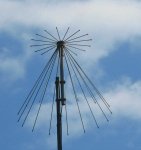Thanks to a tip from Boatanchor, I built my own airband half-wave dipole following the instructions here from VK2ZOI who built amateur-band versions:
Half-Wave Flower Pot Antenna – VK2ZOI
For VHF airband, I used 1-inch pvc, 8 turns of rg-58, and about 20-inches for each element length. Finishing touch included wiping down the pvc and coax coil with Armor-All protectant. At first I just tie-wrapped it all up, and then put it inside without too much detuning.
No, it isn't a hard-core sleeve dipole. But, I found the instructions convenient and appreciated the scaling charts for frequencies other than amateur bands. In this case, the choke's self-resonance is purposely tuned a bit lower than the desired center frequency of the dipole itself.
VHF coax chokes work to an extent if the diameter is kept small, and you don't wind too many or too little amount of turns.
I did nearly the same thing awhile back with nothing but #43 ferrites as a choke, but found that this simple antenna is easy to build and reasonable in performance. Certainly much more than the old "just fold back the braid" technique.
Thanks again Boatanchor for the heads up on this.
Half-Wave Flower Pot Antenna – VK2ZOI
For VHF airband, I used 1-inch pvc, 8 turns of rg-58, and about 20-inches for each element length. Finishing touch included wiping down the pvc and coax coil with Armor-All protectant. At first I just tie-wrapped it all up, and then put it inside without too much detuning.
No, it isn't a hard-core sleeve dipole. But, I found the instructions convenient and appreciated the scaling charts for frequencies other than amateur bands. In this case, the choke's self-resonance is purposely tuned a bit lower than the desired center frequency of the dipole itself.
VHF coax chokes work to an extent if the diameter is kept small, and you don't wind too many or too little amount of turns.
I did nearly the same thing awhile back with nothing but #43 ferrites as a choke, but found that this simple antenna is easy to build and reasonable in performance. Certainly much more than the old "just fold back the braid" technique.
Thanks again Boatanchor for the heads up on this.







